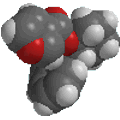 |
Chapter 7 : Stereochemistry |
 |
What are stereoisomers?
- Stereoiosmers are a type
of isomer where the molecules have the same connectivity, except
for the arrangement of those bonds in 2D or 3D space.
- Stereoisomers can be subdivided
into various subfamilies in a couple of different ways :
- Do bonds need to be broken
to interconvert the isomers ?
- No.... conformational
(chapter 3) - these can be interconverted by s bond
rotations. Review ?
- Yes...configurational - bonds need
to be broken to interconvert the isomers.
- Are the stereoisomers mirror images ?
- If yes and they are superimposable mirror images, then these are the same molecule (identical)
- If yes and they are non-superimposable mirror images, then these are enantiomers
- If no, then these are diastereomers
Note that the term diasteromers is therefore quite general and other types of stereoisomers are subsets of the diastereomer group e.g. cis-trans isomers or conformational isomers
We will be expanding on some of these
terms in the rest of this chapter.
The maximum number of stereoisomers
with "n" chirality centers is 2n - due to the number
of permutations possible.
Study Tip : note
that stereoisomers have the same name except for prefixes that identify
the spatial arrangement of the bonds :
cis- or trans-,
E- or Z- for alkenes e.g. cis-2-butene and trans-2-butene
R- or S- for optical isomers
molecules (more on this later)
|
Questions
- Which of the following
are stereoisomers ?
cis-2-hexene, trans-2-hexene, cis-3-hexene and
Z-3-methyl-2-pentene
|
ANSWER?
|
Important
properties of stereoisomers that you should know:
- Stereoisomers have
the same molecular formula, and the same connectivity except
for the arrangement in 2D or 3D space.
For example, cis- and trans-but-2-ene both contain 2 CH3- groups, 2 H- and a C=C.
Both can be represented generically as CH3CH=CHCH3 (i.e. same connectivity).
But they are stereoisomers because the pieces are arranged differently in space.
|